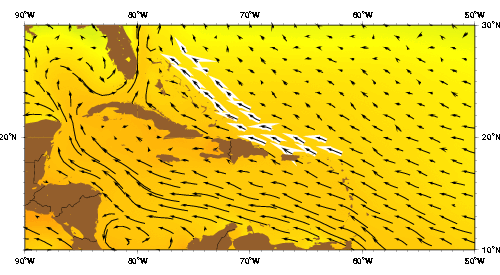 |
The Antilles current was named in 1876 by Krmmel. Subsequent descriptions of the Antilles current consisted primarily of geostrophic calculations based on hydrographic measurements, the first of these being Wust (1924). Iselin introduced speculation as to the existence of an Antilles current when he failed to find evidence of the current in his 1936 study. The Antilles Current's presence had been especially questionable since Leetmaa et al. (1977) were able balance the Sverdrup circulation with the Florida Current alone at this latitude. It was also difficult to see the Antilles Current in topography maps since it's surface expression was comparatively weak.

The Antilles current as represented by the Mariano Global Surface Velocity Analysis (MGSVA). The Antilles Current transports tropical waters from the North Equatorial Current northwestward. It is a significant source of warm water for the Gulf Stream system. Click here for example plots of seasonal averages.
The Antilles current flows northward east of the Antilles and joins the Florida Current past the outer Bahamas. Its waters are concentrated into a strong northward Jet about 80-100 km wide centered at 400 m (Lee et al., 1996). There is evidence for some recirculation and imbalance within this recirculation leads to transport estimates that range from 2-7 Sv (net transport) with a mean northward flow of 5±2 Sv at 27°N (Lee et al., 1996). Olsen et al (1984) found a similar value of 4 Sv along the boundary at 23°N. In contrast, Schmitze and McCartney (1993) reported a much higher value of 12 Sv and Schmitz et al, (1992) report 10 Sv. There does appear to be a variable signal in the Antilles current.
Lee et al. (1996) concluded that the Antilles current serves to balance the interior Sverdrup Circulation not accounted for by the Florida Current and thus does not participate interbasin exchange. Furthermore they found that it is not a continuous flow along the Bahamas and Antilles island chain. This conclusion is supported by the hydrographic study of Gnu and Watts (1982) who found that the Antilles current appeared more as an eddy field along the Bahamas-Antilles arc rather than as a continuous jet. They also noted that even a 10 cm s-1 difference in reference velocity could cause the large (~10 Sv) discrepancies in historical transports due to station spacing and latitude. The discontinuous nature of the current as well as its weak dynamic height signal help to explain why its existence is questionable. Wavelike eddies with periods of 30 and 100 days , a wavelength of 230 km and speeds of 9 cm s-1 are the primary form of variation in the upper 800 m off Abaco. (Lee et al., 1996) Halliwell et al. (1994) found matching properties for baroclinicly unstable waves propagating west. For a 100 day period wave, the mean speed is 4 cm s-1 and wavelength of 335 km, consistent with baroclinic Rossby waves in the region. and similar features have been reported by McWilliams (1976) and Halliwell et al. (1991).
A numerical model predicts that the Antilles Current would have an annual variability of around 10 Sv (Anderson and Corry, 1985). However later empirical studies show little to no evidence of such a signal (Rosenfeld et al., 1989; Lee et al, 1990; Olsen et al., 1984). There would be difficulty in detecting an annual signal since the current is dominated by short term fluctuations. Moorings indicate that the Antilles current is an intensified western boundary current with mean transports of 3.2 ± 7.6 Sv northwards in the upper 800m . In addition there is deeper flow from the Deep Western Boundary Undercurrent below 800 m carrying 33 ± 10.9 Sv southwards (Lee et al., 1990). The influence of this deep flow results in a large, mean southward transport for the entire water column.
ReferencesAnderson, D.L.T., and R.A. Corry, 1985: Seasonal transport variations in the Florida Current: A model study, Journal of Physical Oceanography, 15, 773-786.
Gunn, J.T., and D.R. Watt, 1982: On the currents and water masses north of the Antilles/Bahamas Arc, Journal of Marine Research, 40, 1-48.
Halliwell, G., P. Cornillon and D.A. Byrne, 1991. Westward-propagating SST anomaly features in the Sargasso Sea, Journal of Physical Oceanography, 21, 635-649.
Halliwell, G.R., Jr., J. Peng, and D.B. Olson, 1994: Stability of the Sargasso Sea subtropical frontal zone, Journal of Physical Oceanography, 24, 1166-1183.
Leetmaa, A., P.P. Niiler, and H. Stommel, 1977: Does the Sverdrup relation account for the mid-Atlantic circulation ?, Journal of Marine Research, 36, 311-322.
Lee, T.N., W.E. Johns, R. Zantopp, and E.R. Fillenbaum, 1996: Moored observations of western boundary current variability and thermohaline circulation 26.5°N in the subtropical North Atlantic, Journal of Physical Oceanography, 962-963.
McWilliams, J.C., 1976: Maps from the Midocean Dynamics Experiment. Part I: Geostrophic streamfunction, Journal of Physical Oceanography, 14, 922-935.
Olson, D.B., F.A. Schott, R. J. Zantopp, and K.D. Leaman, 1984: The mean circulation east of the Bahamas as determined from a recent measurement program and historical XBT data, Journal Physical Oceanography, 14, 1470-1487.
Schmitz, W.J., Jr., and M.S. McCartney, 1993: On the North Atlantic circulation, Rev. Geophys., 31, 29-49.
Schmitz, W.J., Jr., J.D. Thompson, and J.R.Luyten, 1992: The Sverdrup circulation for the Atlantic along 24°N, J. Geophys. Res., 97, 7251-7256.
Wust, G., 1924: Florida- und Antillenstrom, Berlin U., Institut f. Meereskunde, Veroff., N.F., A. Geogr.-naturwiss. Reihe, Heft 12, 48 pp.